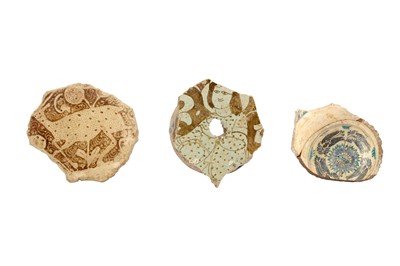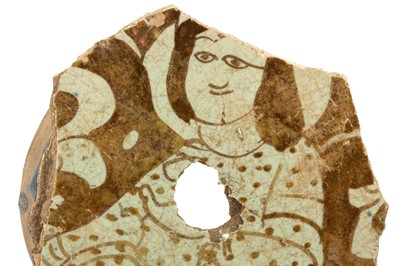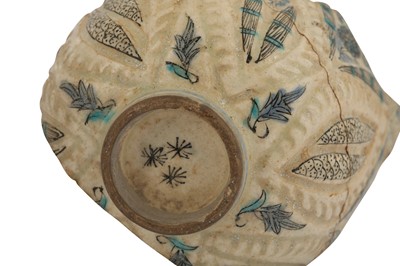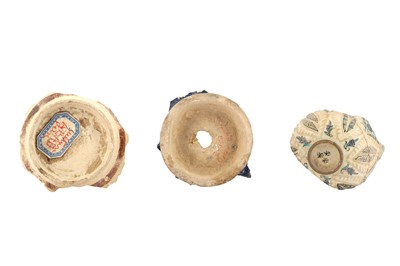29th Oct, 2021 14:00
Islamic & Indian Art
A GROUP OF ISLAMIC POTTERY SHARDS
Kashan, Iran, 12th - first half 13th century and Kutahya, Ottoman Turkey, first half 18th century
A GROUP OF ISLAMIC POTTERY SHARDS
Kashan, Iran, 12th - first half 13th century and Kutahya, Ottoman Turkey, first half 18th century
Comprising two Kashan pottery bowl shards, each resting on a straight circular foot and painted in copper lustre, one with the body of a spotted deer running amidst stylised vegetation, to the underside an elongated octagonal sticker with the words 'Sultanabad Perse' written in red crayon over pencil inventory numbers, 11.5cm diam; another similar featuring a central seated figure in monumental Kashan style, the foot glazed in cobalt blue, another sticker with 'Sultanabad Perse' on the underside, 11.3cm diam; and a Kutahya pottery bowl shard, resting on a short circular foot, the body with a moulded leaf-shaped motif, the inner elements of the leaves painted with circular and linear designs in black and turquoise, further leaves and rosette stems placed between the moulded designs, the inside of the shard painted with a central rosette with tulips springing from it, all painted on a white ground, the underside with three stars imitating the stamps on the base of Chinese porcelains, 8.6cm diam and 6.8cm high.
The attribution stickers on the underside of our two Kashan pottery shards misattribute them as Sultanabad wares. Sultanabad, modern-day Arak, was the location of many finds of ceramic wares dating to the Mongol era. That said, the design rendering combined with a generous use of copper lustre lead to suggest that these shards were probably produced in a 12th-century Kashan kiln (O. Watson, Ceramics From Islamic Lands, 2004).
(Quantity:3)
Dimensions: 8.6cm diam and 6.8cm high
Do you have an item similar to the item above? If so please click the link below to request a free online valuation through our website.





